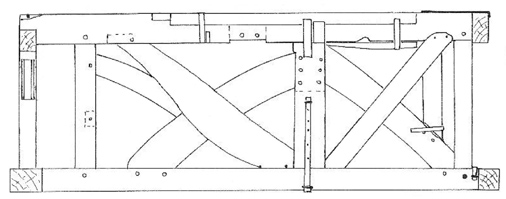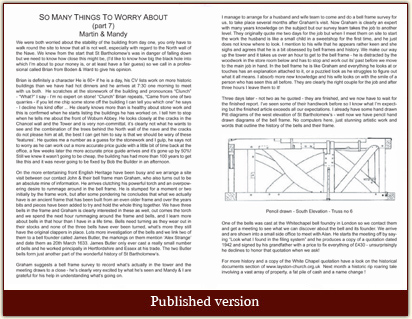Martin & Mandy

We were both worried about the stability of the building from day one; you only have to walk round the site to know that all is not well, especially with regard to the north wall of the Nave. We knew from the start that St Bartholomew's was in danger of falling down but we need to know how close this might be, (I'd like to know how big the black hole into which I'm about to pour money in is, or at least have a fair guess) so we call in a professional called Brian from Boden & Ward to give his opinion.
Brian is definitely a character He is 60+ if he is a day, his CV lists work on more historic buildings than we have had hot dinners and he arrives at 7:30 one morning to meet with us both. He scratches at the stonework of the building and pronounces "Clunch." "What?" I say – I'm no expert on stone! "Clunch," Brian repeats, "Came from one of two quarries – if you let me chip some stone off the building I can tell you which one," he says. I decline his kind offer... he clearly knows more than is healthy about stonework and this is confirmed when he starts listing the buildings he has worked on. I tell him to stop when he tells me about the front of Woburn Abbey. He looks closely at the cracks in the Chancel wall and the Tower and is very non-committal, it's clearly not what he wants to see and the combination of the trees behind the north wall of the nave and the cracks do not please him at all, the best I can get him to say is that we should be wary of these 'features'. He quotes me a number as a guess for the stonework and I gulp, he says not to worry as he can work out a more accurate price guide with a little bit of time back at the office, a few weeks later the more accurate price guide arrives and it's gone up by 50%! Still we knew it wasn't going to be cheap, the building has had more than 100 years to get like this and it was never going to be fixed by Bob the Builder in an afternoon.
On the more entertaining front English Heritage have been busy and we arrange a site visit between our contact John and their bell frame man Graham, who also turns out to be an absolute mine of information. He arrives clutching his powerful torch and an overpowering desire to rummage around in the bell frame. He is stumped for a moment or two initially by the frame work, but after some pondering he concludes that what we actually have is an ancient frame that has been built from an even older frame and over the years bits and pieces have been added to try and hold the whole thing together. We have three bells in the frame and Graham is clearly interested in these as well. Out comes the torch and we spend the next hour rummaging around the frame and bells and I learn more about bells in that hour than I have in a lifetime. Bells need turning as they wear out in their stocks and none of the three bells have ever been turned, what's more they still have the original clappers in place. Lots more investigation of the bells and we link two of them to a bell founder called James Butler, the markings on them mention 'Alex Strange' and date them as 20th March 1633. James Butler only ever cast a really small number of bells and he worked principally in Hertfordshire and Essex at his trade. The two Butler bells form just another part of the wonderful history of St Bartholomew's.
 Graham suggests a bell frame survey to record what's actually in the tower and the meeting draws to a close – he's clearly very excited by what he’s seen and Mandy and I are grateful for his help in understanding what's going on.
Graham suggests a bell frame survey to record what's actually in the tower and the meeting draws to a close – he's clearly very excited by what he’s seen and Mandy and I are grateful for his help in understanding what's going on.
I manage to arrange for a husband and wife team to come and do a bell frame survey for us, to take place several months after Graham's visit. Now Graham is clearly an expert with many years knowledge on the subject but our survey team takes the job to another level. They originally quote me two days for the job but when I meet them on site to start the work the husband is like a small child in a sweetshop for the first time and he just does not know where to look. I mention to his wife that he appears rather keen and she sighs and agrees that he is a bit obsessed by bell frames and history. We make our way up the tower and it takes us over an hour to get to the bell frame – he is distracted by the woodwork in the store room below and has to stop and work out its past before we move to the main job in hand. In the bell frame he is like Graham and everything he looks at or touches has an explanation attached to it, or a puzzled look as he struggles to figure out what it all means. I absorb more new knowledge and his wife looks on with the smile of a person who has seen this all before. They are clearly the right couple for the job and after three hours I leave them to it!
Three days later, not two as he quoted, they are finished and we now have to wait for the finished report. I've seen some of their handiwork before so I know what I'm expecting but the finished article exceeds all our expectations. I already have some hand drawn Pitt diagrams of the west elevation of St Bartholomew's – well now we have pencil hand drawn diagrams of the bell frame. No computers here, just stunning artistic work and words that outline the history of the bells and their frame.
 One of the bells was cast at the Whitechapel bell foundry in London so we contact them and get a meeting to see what we can discover about the bell and its founder. We arrive and are shown into a small side office to meet with Alan. He starts the meeting off by saying, "Look what I found in the filing system," and he produces a copy of a quotation dated 1942 and signed by his grandfather with a price to fix everything of £430 – unsurprisingly he declines to honour that quotation when we ask!
One of the bells was cast at the Whitechapel bell foundry in London so we contact them and get a meeting to see what we can discover about the bell and its founder. We arrive and are shown into a small side office to meet with Alan. He starts the meeting off by saying, "Look what I found in the filing system," and he produces a copy of a quotation dated 1942 and signed by his grandfather with a price to fix everything of £430 – unsurprisingly he declines to honour that quotation when we ask!
For more history and a copy of the Whitechapel quotation, have a look on the historical documents section of www.layston-church.org.uk. Next month an historic rip-roaring tale involving a vast array of property, a fat pile of cash and a name change!
 |
|
 |
